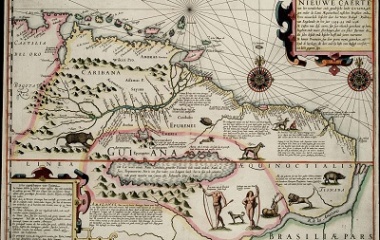The ancient Columbians offered piles of gold in reverence to the sun and in order to maintain harmony with the cosmos. They deposited the abundant precious metal into deep lakes and buried it during mysterious rituals. However, the enigmatic City of Gold that ardent explorers and pillagers have sought since the 16th century has remained elusive to this day.
What Is El Dorado?
Today, the term El Dorado refers to a myth about a mysterious lost City of Gold. El Dorado means golden one or gilded man and was initially a reference to the kings of a Northern Andes tribe called the Muisca. The tribe, in existence from 600 to 1600 AD, performed a coronation ritual which involved vast amounts of gold offerings to the gods. The term later took on a broader meaning, pertaining to a whole lost city and eventually an entire region.
Today, people often use the term El Dorado when describing a great opportunity or place of wealth.
The Golden Ritual
A detailed account of the coronation ritual was recorded by the Spanish author and explorer, Juan Rodriguez Freyle, in his chronicle entitled El Carnero, in 1636 AD. According to Freyle, the Muisca tribe would hold the ceremony at Lake Guatavita. The sacred lake, located near present day Bogotá, is situated in a crater and surrounded by forests, adding to the mystique of the rituals performed there. In the ceremony, the king would be stripped naked, covered in gold dust and sent into the middle of the lake on a raft. Four attendants, laden with gold jewelry, accompanied him. The reed raft would bear additional golden treasures and have burning incense shrouding it from the shore, along with the incense burned on the banks. When the raft reached the center of the lake, the king would dive into the water, be washed clean of his gold coating and emerge as the next ruler of his people.
A famous tunja, a traditional golden figurine, was found in a cave in Columbia in 1856. The tunja is a golden raft, much like the legend, with the king and his aids aboard and steeped with gold jewelry and other treasures.
Columbian Gold
Gold was widely available in ancient Columbia, to the rich and poor alike. It was used as a spiritual offering in worship of the sun, rather than a sign of wealth, as it is in modern society. It was customary for huge quantities of the precious metal to be used in the mystic rituals, in order for the people to remain in harmony with the cosmos. They believed the gold helped them communicate with the supernatural. With the help of hallucinogens, ceremonial participants bedecked with gold were said to transform into animal forms!
The golden offerings were produced by skilled craftsmen through the lost wax technique, according to sources. In this technique, a wax model of the object is made. A mold is then created and the wax model carefully covered in the clay mold. Once the clay has set, the wax model inside is burned away. Molten metal is poured into the mold and left to set. When the metal has cooled sufficiently, the mold is gently opened and the finished golden figurine or object is removed.
Expeditions
Many European expeditions were led in search of El Dorado. The Spanish government became enamored with the reports of abundant gold in the northern regions of South America and wanted to gather as much of the sacred material from El Dorado as they could to melt down and send back to Spain. Yet, the Spanish weren’t the first to seek the mythical lost city. From 1531 to 1538, German explorers Georg von Speyer and Nikolaus Federmann searched current-day Venezuela and Columbia for El Dorado, but were unsuccessful.
Spanish conquistador Gonzalo Jiménez de Quesada discovered Lake Guatavita and the rituals of the Muisca tribe in 1537. Quesada, and the explorers that followed, surmised a fortune in gold lay at the bottom of the lake, after witnessing or hearing of the elaborate offerings made by the locals. In 1545, explorers Lázaro Fonte and Hernán Perez de Quesada attempted to drain Lake Guatavita to access the treasures hidden in its depths. The method they employed entailed a row of men using buckets to drain the water. They managed to drop the level of the lake by three meters, but that was not low enough. The men could only retrieve a few golden treasures from the outer rim of the lake and couldn’t access the center, where they believed the bulk of the golden offerings lay. In 1580, Antonio de Sepúlveda attempted the same feat, but was also unsuccessful. De Sepúlveda sliced away a section of the lake’s rim in order to drain the water, but his experiment killed many of his laborers, when the lake wall collapsed on them.
In 1595, English writer and explorer, Sir Walter Raleigh, set out to find El Dorado. By that period, Lake Parime in Guyana was believed to be the site of the lost city. He did not find El Dorado, but returned on a second expedition in 1617 to try again. He brought his son with on his second attempt and, unfortunately, his son was killed in a battle with the Spanish. Raleigh’s misfortune did not end there. On his return to England, he was put to death for violating the peace treaty with Spain! Lake Parime was labelled El Dorado on English maps until the theory was disproved by a Prussian explorer, more than 150 years later.
Differing belief systems frequently result in the destruction of a culture or religion. Greed has led to the ancient, spiritual treasures of the Columbian people being plundered from their land. Sadly, these sacred artifacts were often melted down and appreciated merely for their material worth or their weight in gold.










